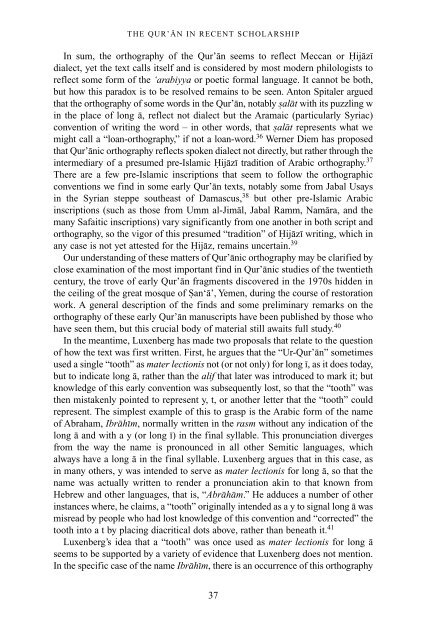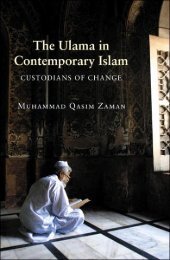The Qur'an in its historical context (pdf - Islam and Christian-Muslim ...
The Qur'an in its historical context (pdf - Islam and Christian-Muslim ...
The Qur'an in its historical context (pdf - Islam and Christian-Muslim ...
You also want an ePaper? Increase the reach of your titles
YUMPU automatically turns print PDFs into web optimized ePapers that Google loves.
THE QUR’AN IN RECENT SCHOLARSHIP<br />
In sum, the orthography of the Qur’an seems to reflect Meccan or Hijazi<br />
dialect, yet the text calls <strong>its</strong>elf <strong>and</strong> is considered by most modern philologists to<br />
reflect some form of the ‘arabiyya or poetic formal language. It cannot be both,<br />
but how this paradox is to be resolved rema<strong>in</strong>s to be seen. Anton Spitaler argued<br />
that the orthography of some words <strong>in</strong> the Qur’an, notably salat with <strong>its</strong> puzzl<strong>in</strong>g w<br />
<strong>in</strong> the place of long a, reflect not dialect but the Aramaic (particularly Syriac)<br />
convention of writ<strong>in</strong>g the word – <strong>in</strong> other words, that salat represents what we<br />
might call a “loan-orthography,” if not a loan-word. 36 Werner Diem has proposed<br />
that Qur’anic orthography reflects spoken dialect not directly, but rather through the<br />
<strong>in</strong>termediary of a presumed pre-<strong>Islam</strong>ic Hijazi tradition of Arabic orthography. 37<br />
<strong>The</strong>re are a few pre-<strong>Islam</strong>ic <strong>in</strong>scriptions that seem to follow the orthographic<br />
conventions we f<strong>in</strong>d <strong>in</strong> some early Qur’an texts, notably some from Jabal Usays<br />
<strong>in</strong> the Syrian steppe southeast of Damascus, 38 but other pre-<strong>Islam</strong>ic Arabic<br />
<strong>in</strong>scriptions (such as those from Umm al-Jimal, Jabal Ramm, Namara, <strong>and</strong> the<br />
many Safaitic <strong>in</strong>scriptions) vary significantly from one another <strong>in</strong> both script <strong>and</strong><br />
orthography, so the vigor of this presumed “tradition” of Hijazi writ<strong>in</strong>g, which <strong>in</strong><br />
any case is not yet attested for the Hijaz, rema<strong>in</strong>s uncerta<strong>in</strong>. 39<br />
Our underst<strong>and</strong><strong>in</strong>g of these matters of Qur’anic orthography may be clarified by<br />
close exam<strong>in</strong>ation of the most important f<strong>in</strong>d <strong>in</strong> Qur’anic studies of the twentieth<br />
century, the trove of early Qur’an fragments discovered <strong>in</strong> the 1970s hidden <strong>in</strong><br />
the ceil<strong>in</strong>g of the great mosque of San‘a’, Yemen, dur<strong>in</strong>g the course of restoration<br />
work. A general description of the f<strong>in</strong>ds <strong>and</strong> some prelim<strong>in</strong>ary remarks on the<br />
orthography of these early Qur’an manuscripts have been published by those who<br />
have seen them, but this crucial body of material still awa<strong>its</strong> full study. 40<br />
In the meantime, Luxenberg has made two proposals that relate to the question<br />
of how the text was first written. First, he argues that the “Ur-Qur’an” sometimes<br />
used a s<strong>in</strong>gle “tooth” as mater lectionis not (or not only) for long i, as it does today,<br />
but to <strong>in</strong>dicate long a, rather than the alif that later was <strong>in</strong>troduced to mark it; but<br />
knowledge of this early convention was subsequently lost, so that the “tooth” was<br />
then mistakenly po<strong>in</strong>ted to represent y, t, or another letter that the “tooth” could<br />
represent. <strong>The</strong> simplest example of this to grasp is the Arabic form of the name<br />
of Abraham, Ibrahim, normally written <strong>in</strong> the rasm without any <strong>in</strong>dication of the<br />
long a <strong>and</strong> with a y (or long i) <strong>in</strong> the f<strong>in</strong>al syllable. This pronunciation diverges<br />
from the way the name is pronounced <strong>in</strong> all other Semitic languages, which<br />
always have a long a <strong>in</strong> the f<strong>in</strong>al syllable. Luxenberg argues that <strong>in</strong> this case, as<br />
<strong>in</strong> many others, y was <strong>in</strong>tended to serve as mater lectionis for long a, so that the<br />
name was actually written to render a pronunciation ak<strong>in</strong> to that known from<br />
Hebrew <strong>and</strong> other languages, that is, “Abraham.” He adduces a number of other<br />
<strong>in</strong>stances where, he claims, a “tooth” orig<strong>in</strong>ally <strong>in</strong>tended as a y to signal long a was<br />
misread by people who had lost knowledge of this convention <strong>and</strong> “corrected” the<br />
tooth <strong>in</strong>to a t by plac<strong>in</strong>g diacritical dots above, rather than beneath it. 41<br />
Luxenberg’s idea that a “tooth” was once used as mater lectionis for long a<br />
seems to be supported by a variety of evidence that Luxenberg does not mention.<br />
In the specific case of the name Ibrahim, there is an occurrence of this orthography<br />
37



